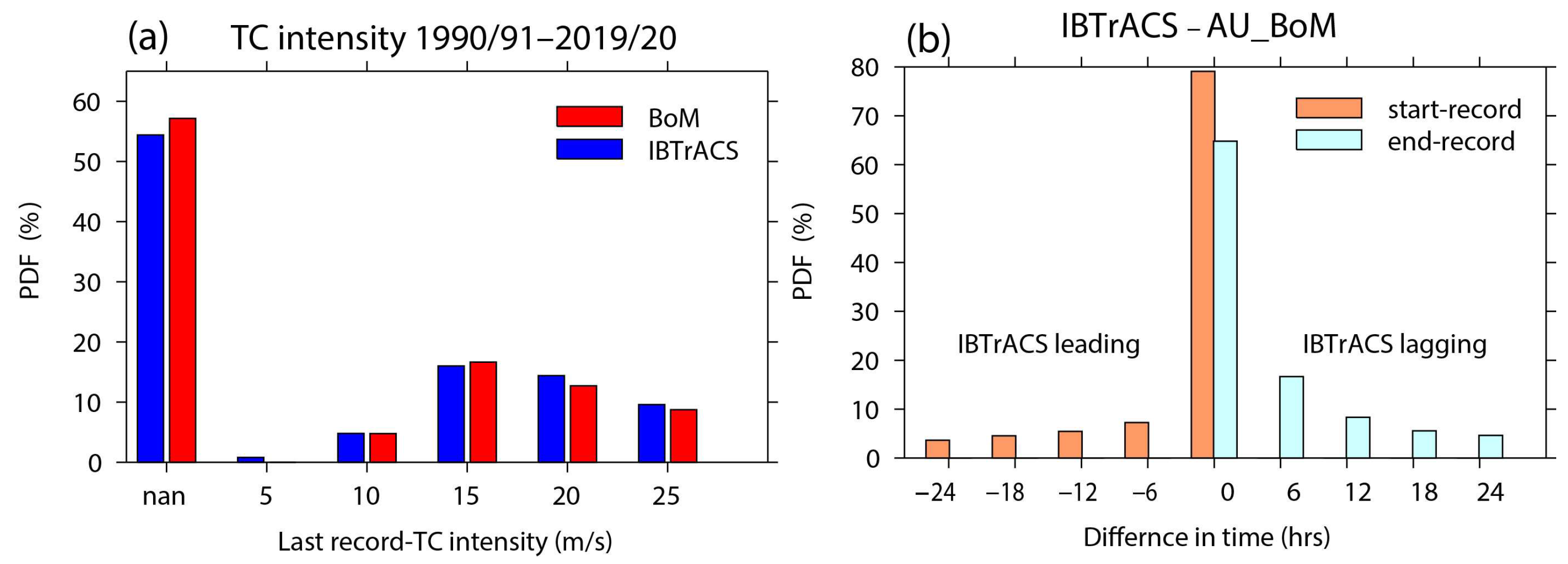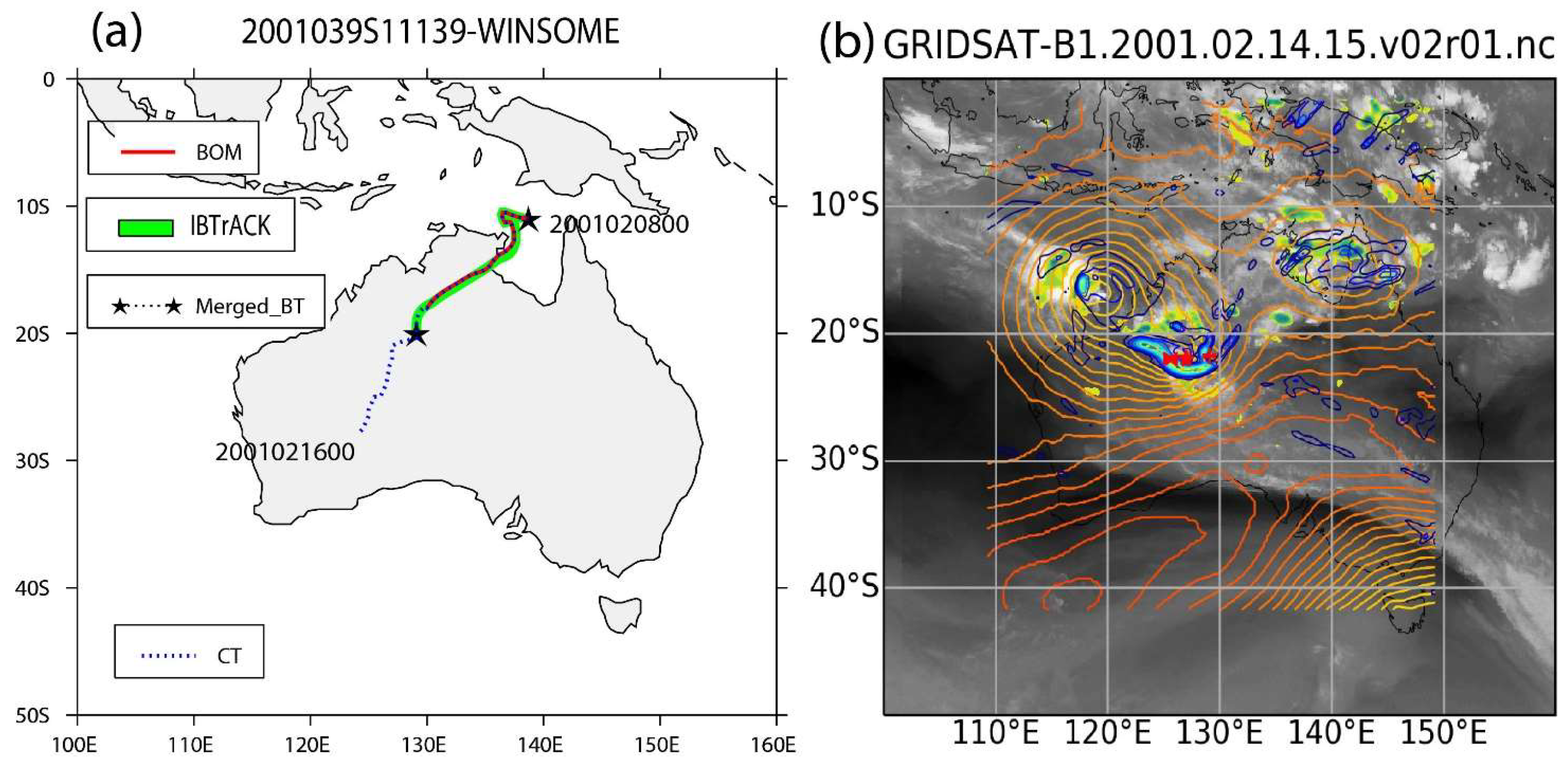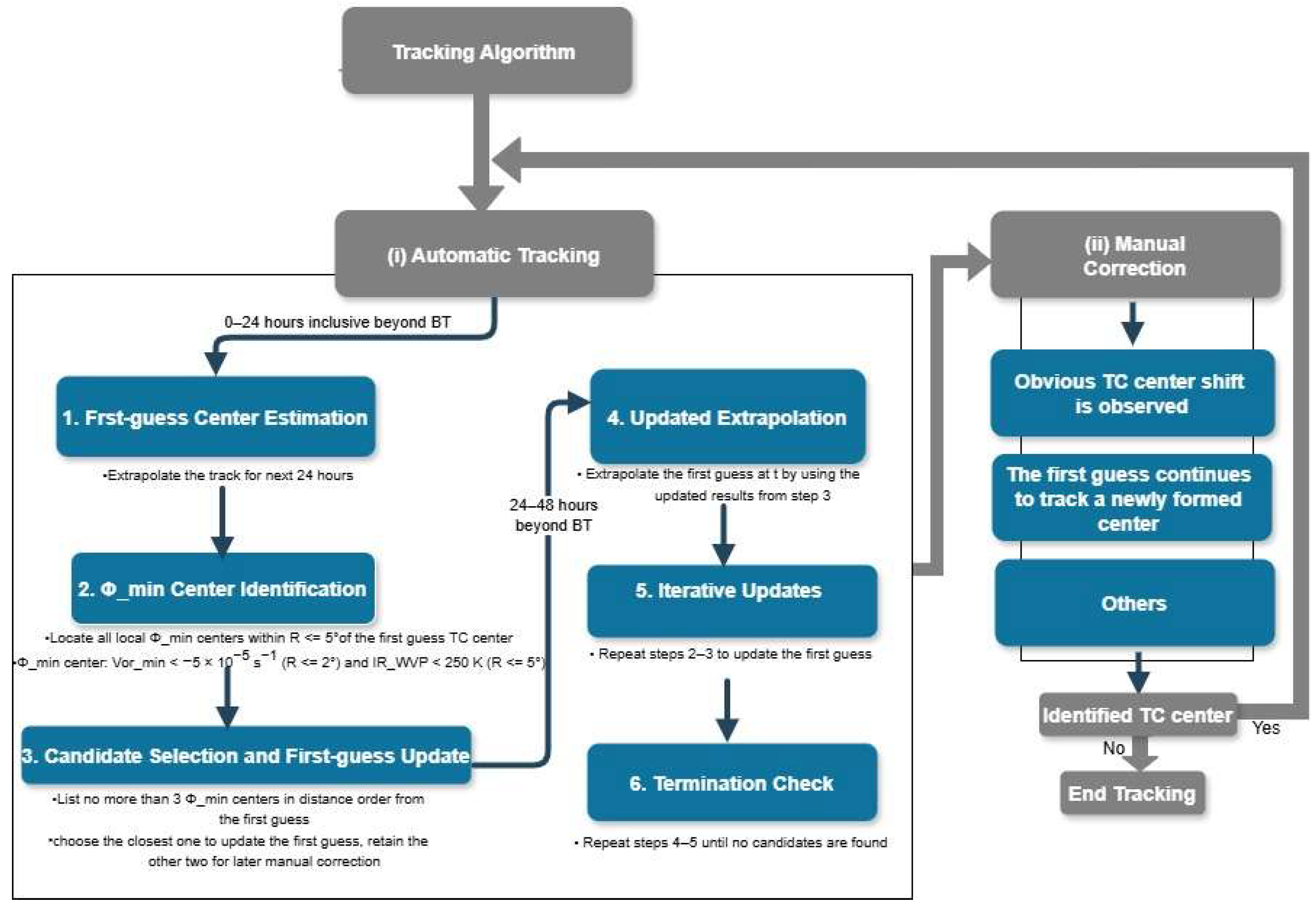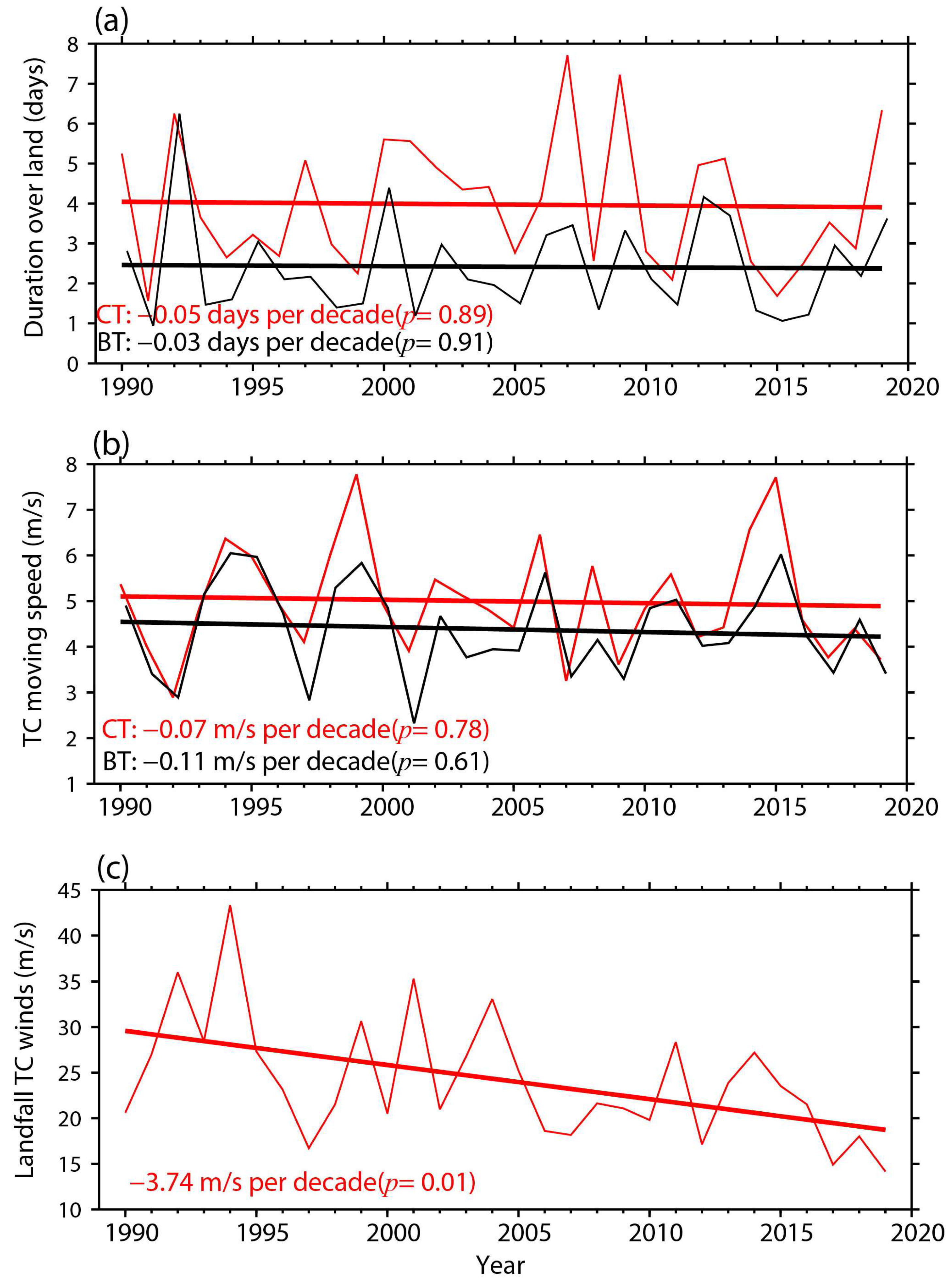A Physical-Based Semi-Automatic Algorithm for Post-Tropical Cyclone Identification and Tracking in Australia
Abstract
1. Introduction
2. Data and Methods
2.1. Observations and Reanalysis
2.2. PTC Track Detection and Tracking Algorithm
- (i)
- Automatic Tracking (for each 3-h time step)
- (1)
- First-guess center estimation:
- Extrapolate the TC track for 24 h to identify a first-guess TC center.
- (2)
- Geopotential Minimum Identification:
- Locate all local geopotential minimum centers within a 5° radius of the first-guess TC center.
- Filter candidates based on two thresholds: (a) the vorticity minimum value must be less than −5 × 10−5 s−1 and within a 2° radius of the geopotential minimum center; and (b) the IR water vapor value within a 5° radius of the geopotential minimum must be less than 230 K.
- (3)
- Candidate Selection and First-guess Update:
- Identify and list up to three local geopotential minimum centers (candidates) ranked by their distance to the first-guess center.
- Update the first-guess TC center with the closest candidate and save the remaining two for potential manual correction.
- (4)
- Updated Extrapolation:
- Extrapolate the first-guess TC center (t) using the updated position from step (3) for the previous 6 h period.
- (5)
- Iterative Updates:
- Repeat steps (2)–(3) to update the first-guess TC center at time(t) for each 3 h time step and save the remaining two candidates.
- (6)
- Termination Check:
- Continue the steps (4)–(5) for up to 48 h beyond the last BT record or terminate early if no valid candidates are identified.
- (ii)
- Manual correction
- Center Adjustment:
- Review and correct the first-guess center when an obvious TC center shift is observed.
- Termination of Tracking:
- Stop tracking when the first-guess TC center continues to track a newly formed center instead of the original TC system.
- Others:
- If some other special cases are found.
3. Results
4. Discussion
5. Conclusions
- Around two thirds of landfalling TCs can be further tracked overland to include their associated PTCs before dissipation, with an additional 1.6 days on average and a maximum of 15 days beyond the last record in IBTrACS.
- Half of post-landfall TCs move more than 1000–1500 km inland from the coast, but only one third of these systems are captured if only the available TC best track archives are used.
- Even though the intensity of Australian landfalling TCs has decreased over the past 30 years, no significant change in overland duration has been found for these post-landfall TCs, indicating they have been able to survive and linger over land for similar periods before dissipating in the past 30 years.
- The research underscores the importance of continuing to track these weak yet still impactful PTCs following landfall to better understand the impact of post-landfall TCs under current and future warming scenarios.
Supplementary Materials
Funding
Data Availability Statement
Acknowledgments
Conflicts of Interest
Abbreviations
| TCs | Tropical Cyclones |
| PTCs | Post-Tropical Cyclones |
| BoM | Bureau of Meteorology |
| IBTrACS | International Best Track Archive for Climate Stewardship |
| BT | Merged best track |
| EPT | Extended PTC track |
| CT | Complete track |
References
- Kossin, J.P.; Olander, T.L.; Knapp, K.R. Trend analysis with a new global record of tropical cyclone intensity. J. Clim. 2013, 26, 9960–9976. [Google Scholar] [CrossRef]
- Sobel, A.H.; Camargo, S.J.; Emanuel, K.A.; Vecchi, G.A.; Knutson, T.R. Human influence on tropical cyclone intensity. Science 2016, 353, 242–246. [Google Scholar] [CrossRef] [PubMed]
- Bhatia, K.; Vecchi, G.; Murakami, H.; Underwood, S.; Kossin, J. Projected response of tropical cyclone intensity and intensification in a global climate model. J. Clim. 2018, 31, 8281–8303. [Google Scholar] [CrossRef]
- Kossin, J.P.; Emanuel, K.A.; Vecchi, G.A. The poleward migration of the location of tropical cyclone maximum intensity. Nature 2014, 509, 349–352. [Google Scholar] [CrossRef]
- Wang, S.; Toumi, R. Recent migration of tropical cyclones toward coasts. Science 2021, 371, 514–517. [Google Scholar] [CrossRef]
- Kossin, J.P. A global slowdown of tropical cyclone translation speed. Nature 2018, 558, 104–108. [Google Scholar] [CrossRef]
- Emanuel, K. Response of global tropical cyclone activity to increasing CO2: Results from downscaling CMIP6 models. J. Clim. 2021, 34, 57–70. [Google Scholar] [CrossRef]
- Li, L.; Chakraborty, P. Slower decay of landfalling hurricanes in a warming world. Nature 2020, 587, 230–234. [Google Scholar] [CrossRef]
- Sainsbury, E.M.; Schiemann, R.K.; Hodges, K.I.; Shaffrey, L.C.; Baker, A.J.; Bhatia, K.T. How important are post-tropical cyclones for European windstorm risk? Geophys. Res. Lett. 2020, 47, e2020GL089853. [Google Scholar] [CrossRef]
- Schumacher, R.S.; Johnson, R.H. Characteristics of US extreme rain events during 1999–2003. Weather Forecast. 2006, 21, 69–85. [Google Scholar] [CrossRef]
- Cheung, H.M.; Chu, J.E. Global increase in destructive potential of extratropical transition events in response to greenhouse warming. npj Clim. Atmos. Sci. 2023, 6, 137. [Google Scholar] [CrossRef]
- Michaelis, A. Climate Change Effects on the Extratropical Transition of Tropical Cyclones in High-Resolution Global Simulations. Ph.D. Dissertation, North Carolina State University Libraries, Raleigh, NC, USA, 2016; p. 156. Available online: http://www.lib.ncsu.edu/resolver/1840.20/36292 (accessed on 15 December 2024).
- Liu, M.; Vecchi, G.; Smith, J.A.; Murakami, H. The present-day simulation and twenty-first-century projection of the climatology of extratropical transition in the North Atlantic. J. Clim. 2017, 30, 2739–2756. [Google Scholar] [CrossRef]
- Chu, J.E.; Vecchi, G.; Murakami, H.; Emanuel, K. Reduced tropical cyclone densities and ocean effects due to anthropogenic greenhouse warming. Sci. Adv. 2020, 6, eabd5109. [Google Scholar] [CrossRef] [PubMed]
- Deng, D.; Ritchie, E.A. An unusual extreme rainfall event in Canberra Australia on February 2018. J. Geophys. Res. Atmos. 2019, 124, 4429–4445. [Google Scholar] [CrossRef]
- Wood, K.; Yanase, W.; Beven, J.; Camargo, S.J.; Courtney, J.B.; Fogarty, C.; Riboldi, J. Phase transitions between tropical, subtropical, and extratropical cyclones: A review from IWTC-10. Trop. Cyclone Res. Rev. 2023, 12, 294–308. [Google Scholar] [CrossRef]
- Khouakhi, A.; Villarini, G.; Vecchi, G.A. Contribution of tropical cyclones to rainfall at the global scale. J. Clim. 2017, 30, 359–372. [Google Scholar] [CrossRef]
- Dare, R.A.; Davidson, N.E.; McBride, J.L. Tropical cyclone contribution to rainfall over Australia. Mon. Weather Rev. 2012, 140, 3606–3619. [Google Scholar] [CrossRef]
- Ng, B.; Walsh, K.; Lavender, S. The contribution of tropical cyclones to rainfall in northwest Australia. Int. J. Climatol. 2014, 35, 2689–2697. [Google Scholar] [CrossRef]
- Bower, E.; Reed, K.A.; Ullrich, P.A.; Zarzycki, C.M.; Pendergrass, A.G. Quantifying heavy precipitation throughout the entire tropical cyclone life cycle. J. Hydrometeorol. 2022, 23, 1645–1662. [Google Scholar] [CrossRef]
- Knapp, K.R.; Kruk, M.C.; Levinson, D.H.; Diamond, H.J.; Neumann, C.J. The International Best Track Archive for Climate Stewardship (IBTrACS): Unifying tropical cyclone data. Bull. Am. Meteorol. Soc. 2010, 91, 363–376. [Google Scholar] [CrossRef]
- Mei, W.; Xie, S.P. Intensification of landfalling typhoons over the northwest Pacific since the late 1970s. Nat. Geosci. 2016, 9, 753–757. [Google Scholar] [CrossRef]
- Knutson, T.; Camargo, S.J.; Chan, J.C.; Emanuel, K.; Ho, C.H.; Kossin, J.; Wu, L. Tropical cyclones and climate change assessment: Part II: Projected response to anthropogenic warming. Bull. Am. Meteorol. Soc. 2020, 101, E303–E322. [Google Scholar] [CrossRef]
- Wang, S.; Toumi, R. More tropical cyclones are striking coasts with major intensities at landfall. Sci. Rep. 2022, 12, 5236. [Google Scholar] [CrossRef] [PubMed]
- Dare, R.A.; Davidson, N.E. Characteristics of tropical cyclones in the Australian region. Mon. Weather Rev. 2004, 132, 3049–3065. [Google Scholar] [CrossRef]
- Deng, D.; Dare, R.; Davidson, N.E. Tropical cyclone rainfall enhancement following landfalling over Australia. In Proceedings of the Australian Meteorological and Oceanographic Society Annual Conference, Canberra, Australia, 5–9 February 2024. [Google Scholar]






Disclaimer/Publisher’s Note: The statements, opinions and data contained in all publications are solely those of the individual author(s) and contributor(s) and not of MDPI and/or the editor(s). MDPI and/or the editor(s) disclaim responsibility for any injury to people or property resulting from any ideas, methods, instructions or products referred to in the content. |
© 2025 by the author. Licensee MDPI, Basel, Switzerland. This article is an open access article distributed under the terms and conditions of the Creative Commons Attribution (CC BY) license (https://creativecommons.org/licenses/by/4.0/).
Share and Cite
Deng, D. A Physical-Based Semi-Automatic Algorithm for Post-Tropical Cyclone Identification and Tracking in Australia. Remote Sens. 2025, 17, 539. https://doi.org/10.3390/rs17030539
Deng D. A Physical-Based Semi-Automatic Algorithm for Post-Tropical Cyclone Identification and Tracking in Australia. Remote Sensing. 2025; 17(3):539. https://doi.org/10.3390/rs17030539
Chicago/Turabian StyleDeng, Difei. 2025. "A Physical-Based Semi-Automatic Algorithm for Post-Tropical Cyclone Identification and Tracking in Australia" Remote Sensing 17, no. 3: 539. https://doi.org/10.3390/rs17030539
APA StyleDeng, D. (2025). A Physical-Based Semi-Automatic Algorithm for Post-Tropical Cyclone Identification and Tracking in Australia. Remote Sensing, 17(3), 539. https://doi.org/10.3390/rs17030539





